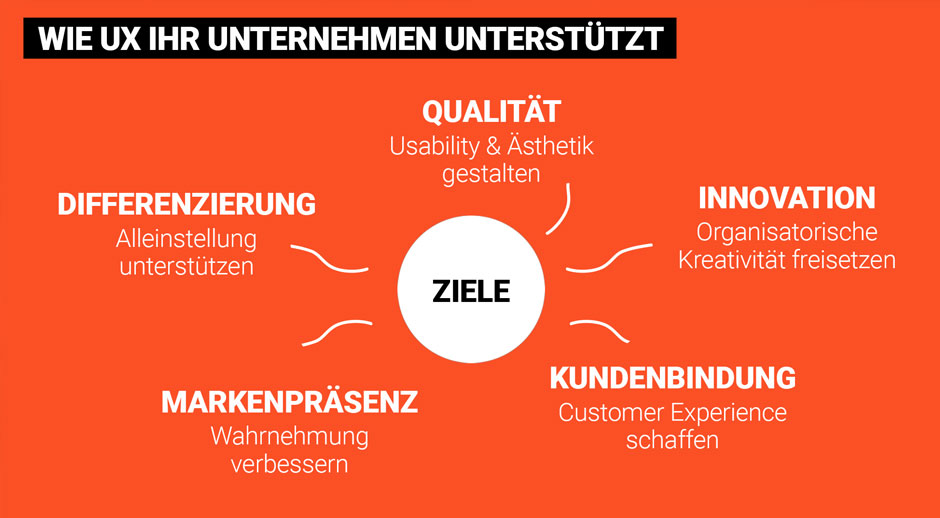17.05.2022
UX KPI: User Experience messen
Eins ist klar: User Experience (UX) ist schon lange kein Nice-to-have mehr und rückt immer mehr ins Bewusstsein der Unternehmen. Früher oder später stellt sich dabei die Frage: Wie könnt ihr eure UX Aktivitäten gezielt steuern? UX Metriken und KPIs sind gute Indikatoren dafür, diese zu messen. Doch wie findet ihr die UX KPIs, die euch und eurer Unternehmen erfolgreicher machen? Was müsst ihr bei der Auswahl beachten? Und was zeichnet erfolgsversprechende KPIs aus? Wir geben euch Antworten auf diese Fragen.
Was sind UX KPIs?
Ein UX KPI (Key Performance Indicator) ist eine Kennzahl, um den Erfolg von UX-Maßnahmen über einen längeren Zeitraum zu messen. Es zeigt, ob und inwieweit ein Unternehmen seine Ziele hinsichtlich UX erreicht hat. Anhand des UX KPI kann das Management den Fortschritt der UX-Maßnahmen bewerten und weitere Entscheidungen ableiten.

Wie definiert ihr euer UX KPI?
UX KPIs sind ein Leuchtturm für Organisationen. Ihr richtet eure Entscheidungen daran aus. Ihr benutzt sie, um euch über aktuelle Prioritäten klar zu werden und eure Ressourcen gezielt einzusetzen. UX KPIs sind eng mit dem Erfolg einer Organisation verknüpft und basieren auf der gesteckten UX-Vision eines Unternehmens. Für User Experience Design unterscheiden wir bei UID 5 grundsätzliche Zielrichtungen (siehe Grafik), wie UX euren Unternehmenserfolg unterstützen kann.
Stellt euch daher immer als erstes die Frage: Welche Ziele verfolgt euer Unternehmen? Und wie kann UX dabei helfen, diese Ziele zu erreichen? Überlegt euch anhand welcher Indikatoren sichtbar wird, dass ihr das Ziel erreicht und bestimmt Kennzahlen, mit denen ihr dies messen könnt. Die Antwort auf diese Fragen ist von Unternehmen zu Unternehmen und von Branche zu Branche sehr unterschiedlich. Unternehmen können Usability und UX Design zum Beispiel einsetzen, um Innovation in der Organisation zu fördern. Hier gibt es schon viele etablierte
Metriken, die den Erfolg solcher Maßnahmen messen – zum Beispiel die Anzahl der neuen Produkte pro 100 Mitarbeitenden. Für viele Unternehmen ist jedoch Qualität das wichtigste Ziel, das sie mit User Experience Design erreichen wollen. Eine gute User Experience soll die Hochwertigkeit der Produkte an die Oberfläche bringen. Menschen nehmen Qualität sehr unterschiedlich wahr. Hier bieten sich Tools wie VisAWI oder AttrakDiff an. Mit diesen bewerten Nutzende subjektiv die Usability und das Design des digitalen Produkts.
Einigkeit über UX KPIs herstellen
Ob Innovation fördern, Qualität unterstreichen oder Kunden binden – egal welche Funktion Usability und User Experience in eurem Unternehmen erfüllt, wichtig ist: Alle Stakeholder müssen sich über diese einig sein. Viele Disziplinen wie Software, Design und Marketing arbeiten daran, User Experience in Produkten und im Unternehmen zu integrieren. Sie können nur erfolgreich sein, wenn Klarheit und Einigkeit über das angestrebte UX-Ziel herrschen.
Was sind typische UX KPIs?
Ihr fragt euch jetzt bestimmt: „Aber welche Standard UX KPIs müssen wir auf jeden Fall im Blick behalten?“ Das hängt ganz von euren jeweiligen UX-Zielen ab. Beispiel: Hat euer Produkt selbst einige überzeugende USPs? Ist UX für euer Produkt ein Hygienefaktor und dient dazu, Qualität zu demonstrieren? Dann könnt ihr getrost KPIs aus Standardmetriken ableiten wie Fehlerquoten, Konversionsraten oder der Adoptionsrate neuer Versionen.

Ist die UX selbst für euch hingegen ein wichtiges Alleinstellungsmerkmal, machen Standard-KPIs nur begrenzt Sinn. Denn ihr wollt euch vom Wettbewerb unterscheiden. Verwenden in einer Branche alle Wettbewerber denselben Leuchtturm, also dasselbe Set an KPIs, dann treffen sie auch ähnliche taktische Entscheidungen. So werdet ihr euch nie voneinander abheben können. Es gibt nicht das „eine“ Nutzungserlebnis und die „eine“ User Experience. Eine App für Achtsamkeit kann ich nicht mit einer Kraftwerkssteuerung vergleichen, eine Business Software nicht mit einer Steuerung für Maschinen. Ein Nutzungserlebnis hat immer eine spezielle Qualität; dazu müssen die UX Metriken passen. Den aktuellen Trend zu Standard KPIs sehen wir daher kritisch. Allerdings: UX KPIs für einzelne Branchen und Anwendungsfälle zu standardisieren, sehen wir als durchaus möglich. Jedoch haben darin bisher noch wenige Unternehmen langfristige praktische Erfahrungen.
Anwendung in der Praxis
Ihr solltet eure UX KPIs regelmäßig überprüfen und konkretisieren, um eure übergreifenden Ziele bestmöglich zu unterstützen. Das zeigt auch das folgende Beispiel: Unser Kunde setzte bereits Usability Tests ein, um seine Produkte zu optimieren. Das UX-Team führte Usability Tests durch und leitete daraus Stories mit Findings ab. Um die Verankerungen von UX in der Organisation besser messbar zu machen, legte unser Kunde folgendes KPI fest: Die Anzahl der Stories, die das Entwicklungsteam umsetzte und so Bedienprobleme beseitigte.

Die Einführung des KPIs hatte verschiedene Auswirkungen: Einerseits stieg die Qualität der Kommunikation zwischen den Teams bzw. Abteilungen: Die UX Designer:innn im Unternehmen bemühten sich, die Findings besser zu kommunizieren, zu priorisieren und den Mehrwert bzw. das Risiko herauszustellen. Andrerseits kam es aber auch zu unerwünschten Nebeneffekten: Die Researcher neigten unbewusst dazu, die Stories zunehmend kleiner zu schneiden. Denn so erhöhte sich die Zahl der umgesetzten Finding und verbesserte sich das KPI. Hier mussten wir gegensteuern. Das KPI basiert nun nicht mehr nur aus der reinen Anzahl der Stories. Vielmehr messen wir auch die damit verbundenen Aufwände. So lässt sich das KPI nicht mehr dadurch beeinflussen, wie klein oder groß die Stories geschnitten werden. Deswegen solltet ihr eure Erfahrungen mit UX KPIs regelmäßig reflektieren, optimieren und aus Erfahrungen für die Zukunft lernen.
Euer Weg zu euren UX KPIs
Ihr müsst euch erst klar darüber werden, welche Ziele User Experience in eurem Unternehmen unterstützen soll? In unserem Workshop „Menschzentrierte Digitalisierung“ gehen wir dieser Frage auf den Grund. Es entsteht ein klares Zielbild, was User Experience für euer Unternehmen leisten kann. Darauf aufbauend skizzieren wir eure UX-Strategie, die euch hilft, dieses Ziel zu erreichen – einschließlich passender UX KPIs, mit denen ihr den Fortschritt messen könnt.










